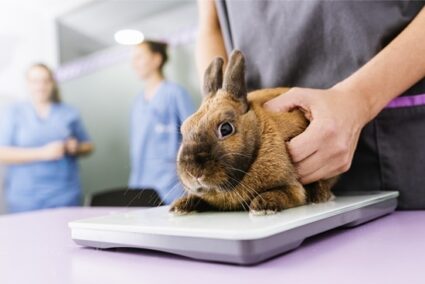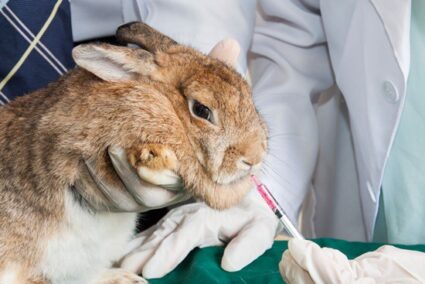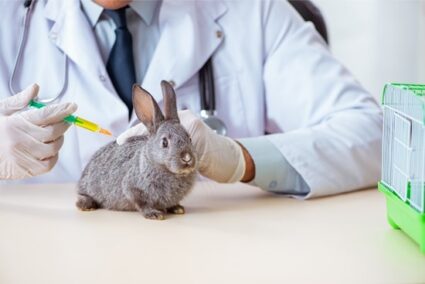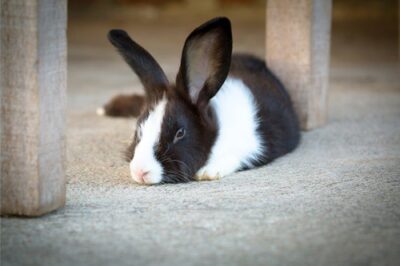Bleeding in rabbits can usually be treated. Paying attention to your rabbit’s physical state is critical as some conditions can be life-threatening. Blood in your rabbits, urine, stools, or vaginal discharge indicates there’s an internal problem that requires immediate veterinary attention.
Reasons for bleeding in rabbits include hematuria (blood in the urine), epistaxis (nosebleeds), reproductive tract dysfunction, anal bleeding, bleeding after neutering, rabbit hemorrhagic disease, and bleeding in the upper digestive tract/oral cavity. Cutting your rabbit’s nails too short can also lead to bleeding. If left uncontrolled, bleeding can lead to further medical complications, such as anemia.
According to the Veterinary Record, the most common causes of anemia in rabbits are bleeding and inflammation. If you notice changes in your pet’s behavior, or any signs of blood in its hutch, appropriate blood tests can confirm the diagnosis of anemia and determine its etiology.
Causes of Blood Loss in Rabbits
Blood loss caused by chronic conditions, trauma, and infection can lead to complications or death if not treated early. Pay close attention to any unusual signs and changes in your pet’s behavior.
Hematuria
Hematuria is the medical term for the presence of blood in the urine. When rabbit owners see red urine, they often worry about bladder and urinary tract infections (UTI’s).
However, actual blood in your rabbit’s urine may not be visible to the naked eye. In most cases, red urine occurs as a result of dietary pigments from food containing beta-carotene or betalain, such as carrots, spinach, and beets.
Hematuria should also not be confused with blood from the reproductive tract of a female rabbit, that can lead to a red tinge in the urine.
According to a review published in the journal, Nature, true hematuria diagnosed via blood that originates with the stream of urine, is a rare condition in rabbits.
Symptoms of Hematuria
- Difficulty urinating
- Abdominal pain on palpation
- Enlarged bladder
- Distended abdomen
- Frequent bruising from excessive clotting
- Perineal dermatitis
- Development of tumor/lumo
- Anorexia
- Lethargy
- Weakness
Hematuria is a symptom of pathology, and not a condition by itself. It typically occurs as a result of problems associated with the urinary tract.
Non-Urinary Causes of Blood in a Rabbit’s Urine
Sometimes the blood you see in your rabbit’s urine may not be originating from the urinary system. The urethra of the female rabbit opens along the wall of the vagina. This can cause certain materials in the vagina to mix with the urine that is being released. Examples include:
- Endometrial venous aneurysm. This occurs when a vein in the uterine lining becomes full of fluid, causing intense pain. Treatment usually involves hysterectomy. According to the Journal of Exotic Pets, the condition has only been found in rabbits.
- Uterine Adenocarcinoma. A cancerous lesion that appears on the uterus, leading to urine in blood. According to Global Veterinaria, the tumor seldom metastasizes. Treatment often includes a hysterectomy.
- Dysfunction of the reproductive tract. This is the most common cause of hematuria in intact females, which is why it is highly recommended that rabbits are sterilized. Causes include enlargement of the uterine tissue and tumors, such as adenocarcinoma.
If you notice anything unusual in your rabbit’s urine, your vet may require a urine sample to perform a dipstick test and urinalysis. To collect your pet’s urine, place your rabbit in a basin after it has had some water. Wait till it pees, and then collect the urine using a syringe.
Epistaxis
Bleeding from the nose can be a one-time occurrence in rabbits or a recurring problem. Either case is not common or normal in rabbits. Epistaxis in rabbits is a serious concern that requires an immediate visit to the vet.
If left untreated, recurrent nose bleeding in rabbits can lead to hypotension, aspiration, hypoxia, and even fatal cardiovascular complications.
Symptoms of Epistaxis
In addition to bleeding from the nose, epistaxis may lead to the following signs and symptoms:
- Sneezing
- Nasal discharge
- Bloodstains on the front paws
- Excessive production of saliva
- Excessive tear production
- Appetite loss
- Black stools (from digested blood), if blood is swallowed
- Blood in stools, urine or other body parts, if there is a hemorrhage
Causes of Epistaxis
A rabbit is susceptible to epistaxis if it lives in unhygienic conditions or if its immune system is weak. The following are some of the most common underlying causes of nose bleeding in rabbits:
- Tooth root abscess
- Bacterial or fungal infection
- Injury to the teeth, typically as a result of chewing on electric cords
- Foreign body in the nose, such as inhaled vegetable matter (seeds and grass)
- Space occupying growths (e.g. abscess) or tumor in the nasal cavity
- Blood clotting disorders, often as a reaction to anticoagulant chemicals
Complications of Epistaxis
Epistaxis is a non-infectious condition in rabbits. Its complications can range from minor issues, such as sneezing, to more severe complications, such as respiratory and circulatory system dysfunctions.
Anemia due to loss of blood is common in rabbits. Swallowing large amounts of blood may also result in digestive system disorders.
Diagnosis of Epistaxis
A wide range of underlying issues can cause epistaxis in rabbits. Therefore, your veterinarian will perform a thorough physical exam. Differential diagnosis will most likely be needed to determine the underlying cause.
A blood profile, including a blood count and chemical blood profile, will be conducted. The blood coagulation time will indicate if the required clotting factors are available to stop the bleeding.
Insufficient clotting factors in the blood can be a cause for uncontrolled bleeding and hemorrhage. Visual diagnostics include:
- X-rays of the cheekbones and skull to assess for growths, tumors or injuries
- X-rays of the chest for signs of malignancy and respiratory system involvement
Depending on the findings, your vet will perform CT scans and MRI to examine for growths or lesions. If growths are found, your vet may perform a biopsy of your pet’s nasal tissues or retrieve samples for bone marrow assessments.
Fluid and blood samples will also be examined for fungal and bacterial infections.
Treatment for Epistaxis
Symptoms will be treated first. Your vet will administer drugs that will stop the bleeding and promote clotting before further complications arise. Antibiotics will be prescribed if there is an infection. Apart from this, treatment will depend on the final diagnosis.

Follow-Up Care
Your pet will be re-examined for its blood clotting time to avoid or manage recurrence.
You will need to check for any clinical signs and symptoms of an epistaxis recurrence. Your pet’s environment will have to be as safe as possible to prevent injury that may cause excessive bleeding. Maintaining hygienic living conditions is a must.
In case of a blood clotting disorder, you’ll need to be particularly observant about preventing accidents, including minor ones. Although rare, not treating the condition quickly and properly can lead to life-threatening anemia and collapse.
Melena
Melena is a rare condition in rabbits that causes tarry-colored or green-black stools from digested blood. It usually occurs due to bleeding in the digestive tract, but can also result from bleeding in the oral cavity or upper respiratory tract. Swallowing of this blood leads to melena in rabbits.
The most common conditions that increase a rabbit’s risk of melena include, stress, unmonitored chewing, and diets rich in simple carbohydrates and low in fiber.
Signs and Symptoms of Melena
In addition to tarry or green-black stool, you’ll also notice:
- Diarrhea or loose stools
- Anorexia and weight loss
- Teeth grinding
- Fecal staining around the anus
- Abdominal distension
- Dehydration
- Stomach ulcers, which is more common among rabbits that are stressed
- Hair loss or unhealthy hair coat
- Pale mucous tissues
Causes of Melena
Common causes of digested blood in rabbit stools include:
- Gastric tumors
- Gastric ulcers, often linked to stress, such as disease, environmental changes, surgery and hospitalization
- Metabolic disorders, such as liver or kidney disease
- Obstruction from tumors or foreign objects in the digestive tract
- Bacterial infection
- Swallowing blood from nasal, sinus or oropharyngeal lesions
- Clotting disorders, as they lead to uncontrolled bleeding
- Reaction to drugs, such as analgesics and corticosteroids
Diagnosis of Melena
Your vet will perform diagnostic tests to rule out melena from other diseases that may change the appearance and consistency of your pet’s feces.
Some of the diagnostic exams may include a urinalysis, a chemical blood profile, a complete blood count, and a thorough assessment of the content, appearance, and consistency of the stools.
The results of these tests may indicate the presence of anemia if a bleeding disease is responsible.
X-rays of the abdomen may be taken to locate the presence of an intestinal obstruction, foreign body, mass, or fluid accumulation in the abdominal cavity.
Abdominal ultrasonography will determine if there is any thickening of the intestinal wall, a foreign body or gastrointestinal mass. Any object or foreign body will have to be surgically removed.
Treatment of Melena
Treatment will depend on the cause. Melena requires hospitalization for 24 hours to administer medication, fluid therapy, and electrolyte therapy. Antibiotics will be given if there is an infection.
If an abdominal obstruction from a foreign body is suspected, or if your pet has a tumor, a laparotomy will most likely be performed.
The procedure involves making an incision in the abdominal wall. This will also allow your vet to collect a sample for a biopsy, which will confirm whether the tumor is malignant.
At-Home Care of Melena
Your rabbit must drink enough fresh water following treatment. You can encourage this by flavoring your pet’s water with fresh vegetable juice or wetting leafy greens.
Be sure to include plenty of fresh greens, such as romaine lettuce, carrot tops, collard greens, spinach, parsley, and high-quality grass hay that have been moistened.
Your goal should be to get your pet to eat well following its treatment so that it maintains its weight and nutritional status. Offer your rabbit its regular pelleted meals, if it prefers them.
You may have to syringe feed your rabbit a gruel mixture if it refuses to eat, until it can eat on its own again. Tube feeding is another method that may be more suitable. Avoid giving your rabbit any high-carb and high-fat supplements, unless recommended by your vet.
In some cases, leafy greens may worsen diarrhea. If this is the case, try offering it a diet with high-quality grass hay only. Consult with a vet before making changes to your rabbit’s diet.

Bleeding From The Nail
Cutting a rabbit’s nail too short, or at the “quick,” can lead to bleeding. The quick is a vein located inside the rabbit’s claw. It’s a sensitive region, which can cause intense pain and bleeding if injured.
Making sure your rabbit’s claws are trimmed regularly is vital because your pet is not able to dig and wear down its claws inside your home. If left untrimmed, the claws grow too long and curls inside your rabbit’s feet or snag on objects, causing discomfort.
Applying styptic powder or flour can help to stop the bleeding.
Viral Haemorrhagic Disease
Rabbit hemorrhagic disease (RHD) is a highly contagious, sudden, and fatal viral disease that occurs in rabbits of the Oryctolagus cuniculus species.
This includes domestic and wild European rabbits. The condition often leads to blood discharge from the nose or blood spots in the eyes.
Signs and Symptoms of RHD
It takes 1-5 days for a rabbit to get sick after being exposed to the virus. It’s common for rabbits to die within a short period of being sick, or die suddenly without signs. Common signs of RHD include:
- Bloody and frothy discharge from the nose
- Blood spots in the eyes
- Depression
- Fever
- Loss of appetite
- Groaning
- Neurological signs, such as paddling of the legs, difficulty walking, seizures, and paralysis
It’s not common for RHD to be chronic. Signs of chronic RHD often include:
- Weight loss
- Appetite loss
- Jaundice
- Abdominal bloating
- Diarrhea
Chronic RHD eventually leads to death from liver disease.
How Does RHD Spread?
RHD is caused by a highly contagious virus called the rabbit hemorrhagic disease virus (RHDV), or rabbit calicivirus (RCV). A new strain of the virus (RHDV2) has emerged in France. Because the virus only affects rabbits, it has been used in some countries to control rabbit populations.
The infection is transmitted between rabbits via direct contact with infected urine, saliva, blood, runny nose, manure, fur, or carcasses. The virus can also spread through infected objects, such as water, food, bedding, and cages.
Humans can transmit RHDV through their hands, clothing, and footwear after contact with an infected rabbit. Car tires can transmit the virus after traveling through a region with infected rabbits.
Diagnosis and Treatment
RHD is suspected in cases of unexplained and sudden illness or death, if multiple rabbits are involved, or if there is bleeding.
Laboratory tests, such as reverse transcription-polymerase chain reaction (RT-PCR), negative staining, Western blotting, immunoelectron microscopy, and ELISAs may be performed on samples from the blood, spleen, liver, and other organs.
Unfortunately, there is no treatment for RHD, and affected rabbits are humanely euthanized.
Can RHD Be Prevented?
There are many vaccines available against RHD in the UK. In Canada, no vaccine is licensed for general use, but in some situations, it may be made available via a special process with the help of the CFIA.
Good biosecurity is the best way to prevent RHD. Some techniques include:
- Always quarantine new rabbits
- Both the owner and the pet rabbit should avoid contact with wild rabbits
- Wash hands, cages, clothing and equipment when handling rabbits from different sources
Bleeding from the Anus
Any abnormalities (bleeding or growth) in your rabbit’s anal region or bottom warrants a trip to the vet’s office. Understanding problems with the anus can prepare you if you notice unusual signs, such as straining in the litter box, mass protruding from your rabbit’s back end and blood on the floor.
Anal Polyps
Polyps are among the most common problems of the anus, where an overgrowth of the mucous membrane in the rectum sticks through the anal opening.
Bleeding from the anus is the most common symptom of anal polyps. Although polyps are often benign, there is a chance that one may grow large enough to block the rectum. In such cases, surgical removal is the only form of treatment.
Anal polyps may appear pink, red, or brown due to inflammation or changes in anal or rectal tissue. Lack of fiber in a rabbit’s diet can change the texture and shape of its stool, leading to inflammation of the delicate tissue in the rectum and anus.
Multiple polyps may cause feces to come out from in between them. If there is no anal blockage or pain, you’ll only have to monitor the situation carefully. Surgery is necessary if the polyp(s) cause pain or block the passage of stool.

Papillomas
A papilloma is a tiny and often benign tumor of the skin that may resemble a cauliflower. Papillomas are usually pink or white in color, and bleed easily.
A papiloma will develop at the rectoanal junction and protrude from the anus. However, it can be challenging to detect a papilloma when it is small, unless pressure is applied or when stool is being passed. Papillomas become more visible as they grow and start to protrude.
Papillomas can get crusty and ulcerated. They can also grow large enough to obstruct the anus.
Viral papilloma is rare in domestic rabbits and is sometimes seen in wild cotton ball rabbits. It’s caused by the Shope papilloma virus and is typically benign. However, in some pet rabbits, the virus may cause a malignant growth, thus requiring surgical removal.
Hemorrhoids
Although the two can be difficult to differentiate, a hemorrhoid is a blood-filled, inflamed vein the anus or rectum, whereas a polyp is made up of solid matter.
Hemorrhoids occur as a result of excess pressure on the vein, which can be controlled using a topical anti-inflammatory medication.
Hemorrhoids in rabbits are rare and often small in rabbits. They don’t cause enough swelling to block the anus and often resolve on their own. However, if they do become large, they will have to be surgically removed.
Syphilis
Syphilis in rabbits is caused by the bacterium, Treponema cuniculi and often causes lesions that look similar to papillomas.
However, syphilis lesions are inflamed areas of tissue around the mucocutaneous junction of the anal opening, as well as the lips, eyes, nose and the urogenital regions of a rabbit.
During the early stages of the disease, lesions may appear crusty and raised. As the condition progresses, they develop into large papillary nodules that bleed and ulcerate.
Bleeding After Neutering
Following neutering, most males return to normal health/behavior. However, there are cases where the leftover scrotal sac fills with blood. This can cause the scrotum to become enlarged and purple.
It’s not necessarily harmful to your pet. What you’re seeing is blood leaking into the scrotal sacs as a result of incomplete cauterization of the vessels. Your vet may suggest soothing your pet and applying a cold pack to the affected region (as long as there is no external bleeding).
Check your rabbit’s stitches every day to make sure they aren’t coming out or are being pulled by your rabbit. If your pet has been pulling at its stitches or if you notice any signs of external bleeding, call your vet immediately.

